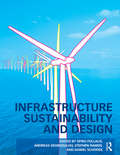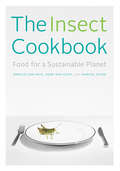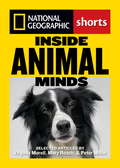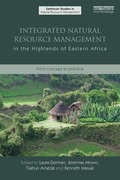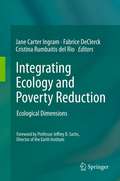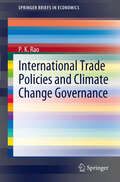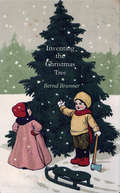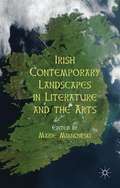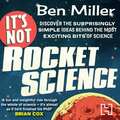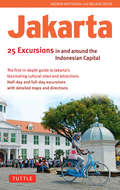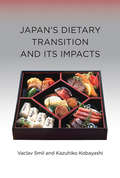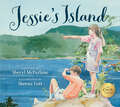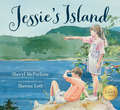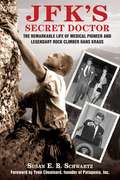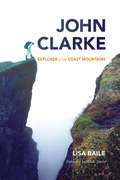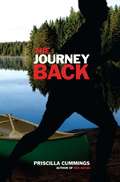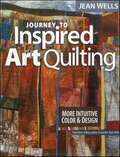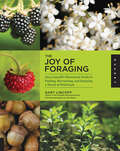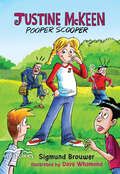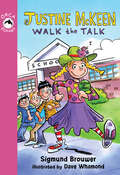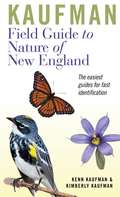- Table View
- List View
Infrastructure Sustainability and Design
by Spiro Pollalis Andreas Georgoulias Stephen Ramos Daniel SchodekYou're overseeing a large-scale project, but you're not an engineering or construction specialist, and so you need an overview of the related sustainability concerns and processes. To introduce you to the main issues, experts from the fields of engineering, planning, public health, environmental design, architecture, and landscape architecture review current sustainable large-scale projects, the roles team members hold, and design approaches, including alternative development and financing structures. They also discuss the challenges and opportunities of sustainability within infrastructural systems, such as those for energy, water, and waste, so that you know what's possible. And best of all, they present here for the first time the Zofnass Environmental Evaluation Methodology guidelines, which will help you and your team improve infrastructure design, engineering, and construction.
The Insect Cookbook: Food for a Sustainable Planet (Arts and Traditions of the Table: Perspectives on Culinary History)
by Arnold van Huis Henk van Gurp Marcel DickeThe Definitive Guide to Insects as a Sustainable Food SourceIn The Insect Cookbook, two entomologists and a chef make the case for insects as a sustainable source of protein for humans and a necessary part of our future diet. They provide consumers and chefs with the essential facts about insects for culinary use, with recipes simple enough to make at home yet boasting the international flair of the world's most chic dishes."Invite politicians to dinner and let them tell the world how delicious it is.... They will proudly go around and say, 'I ate crickets, I ate locusts, and they were delicious.'"—Kofi Annan The Insect Cookbook features delicious recipes and interviews with top chefs, insect farmers, political figures, and nutrition experts, including chef René Redzepi, whose establishment was elected three times as "best restaurant of the world"; Kofi Annan, former secretary-general of the United Nations; and Daniella Martin of Girl Meets Bug. The book contains all you need to know about cooking with insects, where to buy them, which ones are edible, and how to store and prepare them at home and in commercial spaces.
The Insect Cookbook
by Françoise Takken-Kaminker Arnold Van Huis Henk Van Gurp Marcel Dicke Diane Blumenfeld-SchaapInsects will be appearing on our store shelves, menus, and plates within the decade. In The Insect Cookbook, two entomologists and a chef make the case for insects as a sustainable source of protein for humans and a necessary part of our future diet. They provide consumers and chefs with the essential facts about insects for culinary use, with recipes simple enough to make at home yet boasting the international flair of the world's most chic dishes.Insects are delicious and healthy. A large proportion of the world's population eats them as a delicacy. In Mexico, roasted ants are considered a treat, and the Japanese adore wasps. Insects not only are a tasty and versatile ingredient in the kitchen, but also are full of protein. Furthermore, insect farming is much more sustainable than meat production. The Insect Cookbook contains delicious recipes; interviews with top chefs, insect farmers, political figures, and nutrition experts (including chef René Redzepi, whose establishment was elected three times as "best restaurant of the world"; Kofi Annan, former secretary-general of the United Nations; and Daniella Martin of Girl Meets Bug); and all you want to know about cooking with insects, teaching twenty-first-century consumers where to buy insects, which ones are edible, and how to store and prepare them at home and in commercial spaces.
Inside Animal Minds: The New Science of Animal Intelligence
by Mary Roach Virginia MorellVirginia Morell provides an overview of the science of animal intelligence. She introduces you to an African gray parrot named Alex, a bonobo named Kanzi, and a border collie named Betsy. Each of these animals tells us something interesting about the way they perceive and manipulate their world. The article also looks at what scientists are learning about the intelligence of dolphins and crows, beyond mere communication. Mary Roach takes us to the savannahs of Senegal to meet a group of 34 chimpanzees, whose behavior and social structures have given scientists some important clues about the nature of their communication and intelligence. Peter Miller looks at the collective behavior of ants, bees, and other insects for what they can tell us about social organization and how sometimes intelligence lies outside of the individual brain. This article served as the basis for his book, The Smart Swarm: How Understanding Flocks, Schools, and Colonies Can Make Us Better at Communicating, Decision Making, and Getting Things Done.
Integrated Natural Resource Management in the Highlands of Eastern Africa: From Concept to Practice (Earthscan Studies in Natural Resource Management)
by Laura German Jeremias Mowo Tilahun Amede Kenneth MasukiThis book documents a decade of research, methodological innovation, and lessons learned in an eco-regional research-for-development program operating in the eastern African highlands, the African Highlands Initiative (AHI). It does this through reflections of the protagonists themselves—AHI site teams and partners applying action research to development innovation as a means to enhance the impact of their research. The book summarizes the experiences of farmers, research and development workers and policy and decision-makers who have interacted within an innovation system with the common goal of implementing an integrated approach to natural resource management (NRM) in the humid highlands. This book demonstrates the crucial importance of "approach" in shaping the outcomes of research and development, and distils lessons learned on what works, where and why. It is enriched with examples and case studies from five benchmark sites in Ethiopia, Uganda, Kenya and Tanzania, whose variability provides the reader with an in-depth knowledge of the complexities of integrated NRM in agro-ecosystems that play an important role in the rural economy of the region. It is shown that the struggle to achieve sustainable agricultural development in challenging environments is a complex one, and can only be effectively achieved through combined efforts and commitment of individuals and institutions with complementary roles.
Integrating Ecology and Poverty Reduction: Ecological Dimensions
by Cristina Rumbaitis del Rio Fabrice Declerck Jane Carter IngramIn the past, the science of ecology has frequently been excluded from the development agenda for various reasons. Increasingly however there has been a renewed interest in finding more ecologically sustainable means of development that have required a strong foundation in ecological knowledge (for example EcoAgriculture Partnerships, EcoHealth presented at ESA, and EcoNutrition proposed by Deckelbaum et al). Each of these examples has already taken the critical first step at integrating ecological knowledge with agriculture, health and nutrition, respectively. However, this is only the first step; more attention needs to be placed not only on the role that two fields can play towards poverty alleviation, but on the role of a truly integrated, interdisciplinary approach towards development goals that is firmly grounded in ecological understanding. We feel that a critical look at what ecology can and cannot provide to the development agenda, in light of the Millennium Development goals, is timely and crucial. The introduction and the final section of the book will then integrate the lessons and principles outlined in each of the chapters. All chapter authors will be heavily encouraged to focus on how their sub-discipline in ecology impacts overall human well-being and environmental sustainability.
International Trade Policies and Climate Change Governance
by P. K. RaoThis work offers a synthesis of the current approaches toward an integration of international trade and climate change, with a view to fostering potential improvements in policies and institutions affecting these. A number of pragmatic measures are proposed with reference to the WTO and the United Nations Framework Convention on Climate Change (UNFCCC) regimes, which are expected to contribute toward enhanced climate change governance, as well as promoting international trade.
Introduction to Modern Climate Change
by Andrew E. DesslerThis textbook is tightly focused on the problem of anthropogenic climate change. It is unique among textbooks on climate change in that it combines an introduction of the science with an introduction to the non-science issues such as the economic and policy options. Unlike more purely descriptive textbooks, it contains the quantitative depth that is necessary for an adequate understanding of the science of climate change. The goal of the book is for a student to leave the class ready to engage in the public policy debate on this issue. This is an invaluable textbook for any introductory survey course on the science and policy of climate change, for both non-science majors and introductory science students.
Introduction to the Physical and Biological Oceanography of Shelf Seas
by John H. Simpson Jonathan SharplesIn this exciting and innovative textbook, two leading oceanographers bring together the fundamental physics and biology of the coastal ocean in a quantitative but accessible way for undergraduate and graduate students. Shelf sea processes are comprehensively explained from first principles using an integrated approach to oceanography that helps build a clear understanding of how shelf sea physics underpins key biological processes in these environmentally sensitive regions. Using many observational and model examples, worked problems and software tools, the authors explain the range of physical controls on primary biological production and shelf sea ecosystems. Boxes throughout the book present extra detail for each topic and non-mathematical summary points are provided for physics sections, allowing students to develop an intuitive understanding. The book is fully supported by extensive online materials, including worked solutions to end-of-chapter exercises, additional homework/exam problems with solutions and simple MATLAB and FORTRAN models for running simulations.
Inventing the Christmas Tree
by Benjamin A. Smith Bernd BrunnerA colorfully decorated Christmas tree, lit with twinkling lights, provokes awe and delight. We understand the lighted tree as a central symbol of the Christmas season, but what are the roots of the tradition? Who first thought to bedeck a tree, to bring it inside? How and where did the local activity grow into a widespread tradition, and how has the Christmas tree traveled across time and continents? Bernd Brunner's brief history--enriched by a selection of delightful and unusual historical illustrations--spans many centuries and cultures to illuminate the mysteries of the Christmas tree and its enduring hold on the human imagination. Tracing various European traditions from the Middle Ages forward, Brunner finds that only in the nineteenth century did Christmas trees become common in European family homes. In North America, the imported custom soon fascinated, though some found the tree not quite compatible with a Puritan mindset. Brunner explores how the Christmas tree entered mainstream American culture and how in recent times it has become globally popular. He introduces Jacqueline Kennedy's Nutcracker Tree in the White House, trees used to celebrate the New Year in Turkey, and the world's most expensive Christmas tree, erected in Abu Dhabi. The author also considers the place of the artificial tree and the ecological dimensions of the Christmas tree trade. A book rich with anecdote and insight, Inventing the Christmas Tree will enchant a wide audience.
Irish Contemporary Landscapes in Literature and the Arts
by Marie MianowskiLooking at representations of the Irish landscape in contemporary literature and the arts, this volume discusses the economic, political and environmental issues associated with it, questioning the myths behind Ireland's landscape, from the first Greek descriptions to present day post Celtic-Tiger architecture.
It's Not Rocket Science
by Ben MillerThe Top Ten BestsellerBlack holes. DNA. The Large Hadron Collider. Ever had that sneaking feeling that you are missing out on some truly spectacular science? You do? Well, fear not, for help is at hand. Ben Miller was working on his Physics PhD at Cambridge when he accidentally became a comedian. But first love runs deep, and he has returned to his roots to share with you all his favourite bits of science. This is the stuff you really need to know, not only because it matters but because it will quite simply amaze and delight you. 'Let me show you another, perhaps less familiar side of Science; her beauty, her seductiveness and her passion. And let's do it quickly, while Maths isn't looking' - Ben Miller 'This book makes climate change actually seem interesting. Not just important - it's obviously important - but interesting. As a result I bought lots of other books about climate change, something I now regret'- David MitchellBen Miller is, like you, a mutant ape living through an Ice Age on a ball of molten iron, orbiting a supermassive black hole. He is also an actor, comedian and approximately one half of Armstrong & Miller. He's presented a BBC Horizon documentary on temperature and a Radio 4 series about the history of particle physics, and has written a science column for The Times. He is slowly coming to terms with the idea that he may never be an astronaut.
It's Not Rocket Science
by Ben MillerThe Top Ten BestsellerBlack holes. DNA. The Large Hadron Collider. Ever had that sneaking feeling that you are missing out on some truly spectacular science? You do? Well, fear not, for help is at hand.Ben Miller was working on his Physics PhD at Cambridge when he accidentally became a comedian. But first love runs deep, and he has returned to his roots to share with you all his favourite bits of science. This is the stuff you really need to know, not only because it matters but because it will quite simply amaze and delight you.'Let me show you another, perhaps less familiar side of Science; her beauty, her seductiveness and her passion. And let's do it quickly, while Maths isn't looking' - Ben Miller'This book makes climate change actually seem interesting. Not just important - it's obviously important - but interesting. As a result I bought lots of other books about climate change, something I now regret'- David MitchellBen Miller is, like you, a mutant ape living through an Ice Age on a ball of molten iron, orbiting a supermassive black hole. He is also an actor, comedian and approximately one half of Armstrong & Miller. He's presented a BBC Horizon documentary on temperature and a Radio 4 series about the history of particle physics, and has written a science column for The Times.He is slowly coming to terms with the idea that he may never be an astronaut.
Jakarta: 25 Excursions in and Around the Indonesian Capital
by Melanie Wood Andrew WhitmarshLinking over 500 activities and attractions into 25 half-day and full-day excursions, this is the first in-depth book on Jakarta that tells you exactly where to go, what to do and how to get there in order to maximize your enjoyment of the city.
Japan's Dietary Transition and Its Impacts (Food, Health, and the Environment)
by Vaclav Smil Kazuhiko KobayashiAn examination of the transformation of the Japanese diet from subsistence to abundance and an assessment of the consequences for health, longevity, and the environment.In a little more than a century, the Japanese diet has undergone a dramatic transformation. In 1900, a plant-based, near-subsistence diet was prevalent, with virtually no consumption of animal protein. By the beginning of the twenty-first century, Japan's consumption of meat, fish, and dairy had increased markedly (although it remained below that of high-income Western countries). This dietary transition was a key aspect of the modernization that made Japan the world's second largest economic power by the end of the twentieth century, and it has helped Japan achieve an enviable demographic primacy, with the world's highest life expectancy and a population that is generally healthier (and thinner) than that of other modern affluent countries. In this book, Vaclav Smil and Kazuhiko Kobayashi examine Japan's gradual but profound dietary change and investigate its consequences for health, longevity, and the environment.Smil and Kobayashi point out that the gains in the quality of Japan's diet have exacted a price in terms of land use changes, water requirements, and marine resource depletion; and because Japan imports so much of its food, this price is paid globally as well as domestically. The book's systematic analysis of these diverse consequences offers the most detailed account of Japan's dietary transition available in English.
Jessie's Island
by Sheryl McFarlane Sheena LottAs Jessie looks out over her island home, she sees a world of endless variety, from killer whales in the strait and bald eagles soaring overhead to anemones and tiny hermit crabs on the shore. She thinks of countless days spent exploring, fishing, swimming and canoeing. Told with lyric simplicity, this story is more than a celebration of West Coast life; it is also a reminder of the joy of childhood and the thrill of discovery. In a time when our children's entertainment has become increasingly formal and high-tech, Jessie's Island reminds us of the joy of unstructured play and the pleasures to be found in the natural world around us.
Jessie's Island
by Sheryl McFarlaneWith a long list of activities and events to attend, cousin Thomas paints a picture of city life that makes Jessie’s world seem a little dull in comparison. When her mother suggests they invite Thomas to visit their island, Jessie wonders glumly what she could possibly write in her letter that would sound as exciting as zoos, planetariums or video arcades. But as Jessie looks out over her island home, she sees a world of endless variety, from killer whales in the strait and bald eagles soaring overhead to anemones in tide pools and tiny hermit crabs on the shore. She thinks of countless days spent exploring, fishing, swimming and canoeing.
JFK's Secret Doctor: The Remarkable Life of Medical Pioneer and Legendary Rock Climber Hans Kraus
by Susan E.B. SchwartzSet against the grand panorama of twentieth-century world events, it captures the remarkable life and spirit of climbing and medical visionary Hans Kraus (1905-1966). Kraus was taught English by James Joyce, escaped Nazi dominated Europe, and was JFK’s secret back specialist. A legendary rock climber known for hair-raising ascents on two continents, Kraus lived a life filled with tragedy and triumph, intense passion, verve, and a whole lot of guts, glory, and wit. One of the great unsung medical pioneers of the twentieth century, Kraus made headline news throughout the second half of the 1950s, was a guest of honor at Eisenhower’s White House, and was the subject of cover stories in major magazines throughout America, including Sports Illustrated. His pioneering work in muscles and fitness uncovered a shocking truth about a lack of fitness in American children, and his work curing back pain brought him into the Kennedy White House and inner circle of Camelot. Here now is the life of Hans Kraus, including the behind-the-scenes story of Kennedy’s crippling back problems, based on new documentation, including White House medical records and interviews with two Kennedy White House doctors. Skyhorse Publishing, as well as our Arcade imprint, are proud to publish a broad range of books for readers interested in history--books about World War II, the Third Reich, Hitler and his henchmen, the JFK assassination, conspiracies, the American Civil War, the American Revolution, gladiators, Vikings, ancient Rome, medieval times, the old West, and much more. While not every title we publish becomes a New York Times bestseller or a national bestseller, we are committed to books on subjects that are sometimes overlooked and to authors whose work might not otherwise find a home.
John Clarke
by Lisa BaileClarke had no interest in "trophy climbs" and never did ascend many of BC's highest peaks. On the other hand, he explored more virgin territory and racked up more first ascents than any other climber-perhaps more than any climber who ever lived.Although he came to be honoured far and wide and is one of the few mountaineers to be awarded the Order of Canada, he was a modest man who pursued his passion without fanfare, frequently embarking on gruelling expeditions into unknown territory by himself. His reputation spread and grew to legendary proportions, not just owing to the prodigious scale of his achievements, but because of the way he carried them out-he travelled light and scorned technology, wearing cotton long johns and eating homemade granola.He dedicated his life to exploring the numberless, nameless peaks of the Coast Range and worked at odd jobs just long enough to pay for the next season's climbing. He was charismatic and famously attractive to women, but none were able to compete with his first love and he didn't marry until he was almost fifty. Always a popular lecturer, in his later years he devoted his considerable energies to the cause of environmental education. After he succumbed to cancer in 2003, the BC government named Mount John Clarke in his honour-fitting recognition for the man who had himself named many BC mountains.John Clarke: Explorer of the Coast Mountains covers this remarkable life from beginning to end, examining Clarke through his own words and pictures as well as through the words of his many friends. All agree it was an honour to have known him, and readers will find it equally inspiring to meet him through these pages.
The Journey Back
by Priscilla CummingsEscaped and on the run, can Digger find redemption? His bold escape from a juvenile detention facility nearly kills him, but soon an angry fourteen-year-old Digger is on the run, hijacking a tractor trailer, "borrowing" a bicycle, and stealing a canoe. When injuries stop him, Digger hides at a riverside campground, where he befriends a young boy and a girl his own age. New friends, a job caring for rescued horses, and risking his life to save another make Digger realize that the journey back is not just about getting home, it's about discovering what he's really running from, and how to come to terms with his troubled past.
Journey to Inspired Art Quilting: More Intuitive Color & Design
by Jean WellsDiscover your artistic voice Expand your creative horizons and embrace the process of developing your design skills using your own intuition. Jean provides you with more design guidelines and new exercises to hone your natural intuitive skills, then she encourages you to go out there and express yourself! Packed with inspiring quilt images, this book walks you through effective approaches to art quilting from journaling your ideas to unifying your design. • Continue your art quilting journey with Jean in this follow up to Intuitive Color & Design • Learn how to recognize those "big ideas" that become inspirational starting points for your art • 9 classroom-tested design assignments help you trust your creative instincts and develop distinctive work
The Joy of Foraging: Gary Lincolff's Illustrated Guide to Finding, Harvesting, and Enjoying a World of Wild Food
by Gary LincoffDiscover the edible riches in your backyard, local parks, woods, and even roadside with tips from the author of The Complete Mushroom Hunter.In The Joy of Foraging, Gary Lincoff shows you how to find fiddlehead ferns, rose hips, beach plums, bee balm, and more, whether you are foraging in the urban jungle or the wild, wild woods. You will also learn about fellow foragers—experts, folk healers, hobbyists, or novices like you—who collect wild things and are learning new things to do with them every day. Along with a world of edible wild plants—wherever you live, any season, any climate—you’ll find essential tips on where to look for native plants, and how to know without a doubt the difference between edibles and toxic look-alikes. There are even ideas and recipes for preparing and preserving the wild harvest year-round—all with full-color photography. Let Gary take you on the ultimate tour of our edible wild kingdom!“Gary Lincoff’s book provides a good jumping-off place for those who would like to foster an appreciation for the mostly unlooked-for abundance that surrounds people wherever they are, and an ability to find hidden sustenance in everyday places.” —Englewood Review of Books
Justine McKeen, Pooper Scooper (Orca Echoes)
by Sigmund BrouwerJustine McKeen, the Queen of Green is ready for her third adventure! Justine McKeen talks a little too much, bosses a little too much, and tells the truth, just not all at once. She's trying to save the planet, one person at a time, and when she decides to get something done, it's a lot of fun. In Justine McKeen, Pooper Scooper, the third book in the Justine McKeen series, Justine gets her friends to help her clean up the dog poop in the park across from the school board's offices in an effort to get the attention of the superintendent of schools. She hopes the efforts of her crew of cheerful pooper scoopers will help get the superintendent to see that bringing their school librarian back to work is the right thing to do.
Justine McKeen, Walk the Talk (Orca Echoes)
by Sigmund BrouwerMeet Justine McKeen. She's the Queen of Green! She talks a little too much, bosses a little too much and tells the truth, just not all at once. She's trying to save the planet, one person at a time, and when she decides to get something done, it's a lot of fun. In Justine McKeen, Walk the Talk, the second book in the Justine McKeen series, Justine decides there are too many cars idling in front of her school. So she comes up with a solution that should help keep the air cleaner. But she soon discovers not many adults trust her crazy ideas.
Kaufman Field Guide to Nature of New England
by Kenn Kaufman Kimberly KaufmanWhether you're walking in the woods or along the beach, camping, hiking, canoeing, or just enjoying your own backyard, this book will help identify all your nature discoveries. With authoritative and broad coverage, using nontechnical and lively language, this guide is an essential reference for nature lovers living in or visiting New England.
